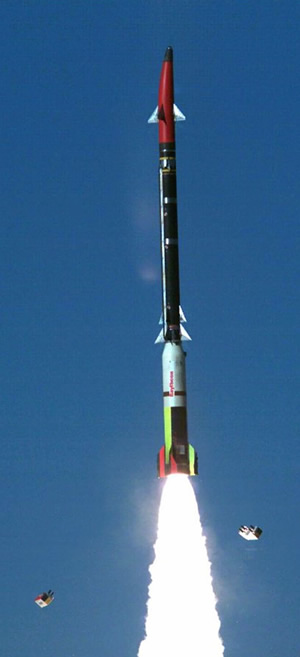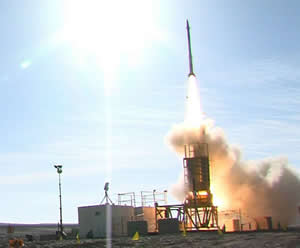
In an intercept test performed last week RAFAEL validated the maturity of the David’s Sling system, scoring a direct hit on a rocket simulating a live medium range rocket. The David’s Sling system was developed under a US-Israeli cooperation; RAFAEL is the prime contractor and development authority with Raytheon the leading subcontractor and US program lead.
The system provides the ultimate indo-atmospheric interceptor, effectively intercepting ballistic missiles and medium range rockets, manned and unmanned aircraft, cruise missiles and various types of guided weapons. The test conducted over southern Israel Nov. 22, 2012 spanning over a large area of the Israeli Negev desert, to realistically depict the weapon’s long-range capability.
This intercept will be followed by gradually more complex testing, leading toward operational fielding. The first David’s Sling unit will stand up in 2013 under the IAF active defense branch, its technical cadre already undergoing training at Rafael. Through 2013 the new unit will train the first cadre of operators for the new system, leading to the system’s initial operational capability in 2014. [nonmember]This is an excerpt version of the full article ($), available to our premium subscribers. To subscribe please follow this link[/nonmember]
[ismember]A video that was recorded through the test, and released by the IMOD clearly follows the different test’s phases. On the first stage a target rocket was fired from one site. David’s sling MMR radar detected the launch and tracked the rocket as it ascended over the horizon. Once the target’s trajectory was determined, the David’s Sling BMC calculated the intercept and ordered the fire unit to launch an interceptor at it. At this intermediary phase the two missiles were flying toward each other, with the Stunner accelerating rapidly to gain speed and height to meet its target over the instrumented range. Once locating the target with its seekers the Stunner headed into the final intercept course, hitting the target rocket, disintegrating it to small pieces upon impact.
The system comprises powerful multi-mission radar, battle management center and fire units carrying the Stunner interceptors. The Stunner missile is designed with long burn multi-phase rocket motor sustaining long burn, and, with multiple control surfaces, supports high kinematic energy from launch to endgame. The Stunner is fitted with a multi band seeker offering optimized interception under all engagement conditions, including adverse weather and intensive countermeasures. The missile uses enhanced kill mechanism employing Hit-To-Kill (HTK), harnessing kinetic energy devastating both high-speed missiles and slower, more maneuvering aircraft alike. The missile is designed for very high maneuverability and high speed, operates in adverse weather conditions and has target change flexibility maximizing the effect of spent assets, particularly against saturation attacks.
As a hit-to-kill weapon, the Stunner missile is comprised of a compact front section riding on a huge rocket motor – the booster segment with its four stabilizing fins strapped to a bearing, and the three-pulse rocket motor. The first two pulses are accelerating the missile through its mid-course trajectory where it maintains course to a location where it should activate its seekers to acquire the incoming missile target. Once reaching this point and upon target detection the missile determines the final intercept strategy and conducts the final phase of its flight, the last rocket pulse is reserved for this phase, kicking in to add speed to maximize kinetic effect. Given its high kinematic budget, the missile can change course to pursue alternative targets or other intercept course throughout its flight, either automatically of by command, depending on policies set by the operating authority.
Stabilization and guidance is performed via aerodynamic control. Two quadruple wing sets laid out in canard scheme are controlled by servo systems, located fore and aft of the missile motor, driven by commands from the Guidance Electronic Unit (GEU) located at the front section. This front section also contains the two seekers, an EO and RF seekers operating simultaneously. The missile also has a datalink unit, receiving target updates and other commands from the ground segments.[/ismember]
For a fixed cost, Stunner would provide far more capabilities than any alternative approaches that would cost four times or more. A simulation of a hypothetical threat from a country possessing long and intermediate range ballistic missiles clearly demonstrates the case for the new Israeli missile. According to the assessment, a ballistic missile strike force comprising 600 SCUD type missiles and 200 long-range missiles, fired from 60-70 TELs could launch tens of missiles could be launched in quick succession over a few minutes. Many could be heading toward critical assets, while the impact points of few others are uncertain, thus requiring complex threat killing strategies.
Two defense strategies were compared. One, investing a billion US$ in current missiles, each worth around $4 million, the country would get around 240 interceptors. Attempting to intercept the threat, defenders will be required to launch at least 60 missiles to repel the attack, expending 25% of the nation’s defensive assets, against 10% of the enemy inventory. With this strategy, the country’s defensive shield will run dry in the fourth round.
In contrast, opting for David’s Sling only, or a mix of David’s Sling and existing interceptors, the same budget could buy 600 David’s Sling interceptors and 100 of the more expensive ones, saved for special purposes. In this case, less than 10% of the defensive shield will be spent to repel the threat (ten ‘golden missiles’ and 50 Stunners) and defenses would be maintained until the attacker runs out of missiles.
[ismember]Rafael is the prime contractor and design authority for the system. Other program partners include IAI Elta, responsible for the MMR radar and Elbit Systems’ Tadiran Systems developing the Battle Management Center (BMC). Raytheon is building the booster and missile-firing unit comprising twelve ready to fire missiles stored in vertical canister-launchers. The missile uses a dedicated datalink providing target updates to the missile, throughout its flight and guiding it to the terminal intercept phase where it acquires the target by its own seekers.
The Stunner missile design represents breakthroughs in the cost/performance of missile defense interceptors. “Employing these interceptors in a threat matched missile mix changes the game of missile defense economics.” Mike Booen, vice president of Raytheon Missile Systems explains. “Raytheon is proud to partner to Rafael of Israel in these efforts” he added. This statement coming from a top executive of the world’s leader in missile technology is a clear endorsement of the Stunner and David’s Sling potential, as it comes with a clear support from Senate and Congress backing the US Missile Defense Agency’s co-funding of the initiative even at a time of budget austerity.[/ismember]
David’s Sling will be fully integrated into Israel’s national multi-layered defense system, receiving constant situational picture and target updates from the system’s integral sensors as well as from other assets, such as the Arrow Weapon Systems’ Green Pine radar, national airspace control system and elevated sensor system providing missile-warning. As a national-centric asset, David’s Sling BMC will receive policy guidelines, target engagement priorities and mission allocations from the national air defense center, pursuing these guidelines independently through its own command, control and battle management system.
The BMC maintains an integrated sky picture, classification and threat assessment, managing the active defense resources, policy and priorities from the national air defense authority.

















